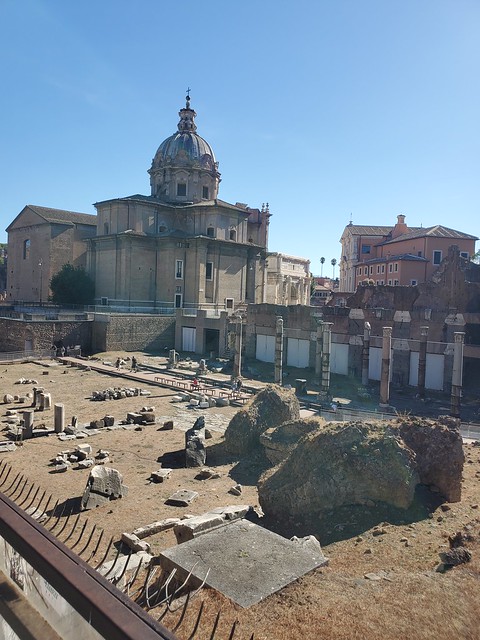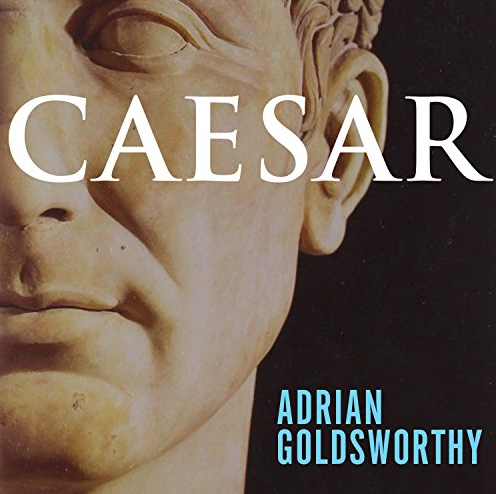Start with our video overview:
Caesar used his great wealth accumulated from the conquest of Gaul to purchase a large portion of land contiguous with the Forum, along the Capitoline Hill slopes (Cicero, Letters to Atticus, 4.16.8). The back end of the forum butted up against the tuff ridge that connected the Quirinal Hill to the Capitoline Hill, removed in the construction of the Forum of Trajan (probably under Domitian).
The forum space consisted of a long narrow piazza, with the Temple of Venus Genetrix on one end (Appian, Civil Wars, 2.102). In the imperial period, a hall was added on the other end (behind the Curia). Caesar had vowed the temple in 48 BC and inaugurated the site on his triumph in 46 BC, before it was completed (Dio History 43.22.1-2); Augustus saw to its completion. It was almost entirely rebuilt by Trajan. There is some portico rebuilding after the fire of Carinus in 283.
The Fascist era anastylosis (architectural restorative technique employing original pieces of ancient building material) of the marble columns of the temple are impressive, with missing portions filled in with small bricks imitating the marble flutes. The columns sustain a portion of the preserved marble frieze and cornice of the Trajanic-era temple. On the temple podium there is also a cast of the Trajanic-era cupid figures that adorned the interior frieze.
Major excavations of the site took place in the 1930s for the construction of the Via dei fori Imperiali. Much of the material found is on currently on display in the Imperial Fora museum in the Markets of Trajan. Excavations continue today, led by the Danish Institute.
Bibliography:
The Museum of the Imperial Forums in Trajan’s Market, Ed. L. Ungaro (Electa 2007).
A. Claridge, Rome, An Oxford Archaeological Guide (Oxford, 2010) 163-169.
Greg Wightman, “The Imperial Fora of Rome: Some Design Considerations,”
Journal of the Society of Architectural Historians, Vol. 56, No. 1 (Mar., 1997), pp. 64-88
Roger B. Ulrich, “Julius Caesar and the Creation of the Forum Iulium,
American Journal of Archaeology, Vol. 97, No. 1 (Jan., 1993), pp. 49-80
L. Richardson, Jr., A New Topographical Dictionary of Ancient Rome (Johns Hopkins 1992) 165-167.
Forum Iulium: the first of the so‑called imperial fora, begun by Julius Caesar and designed, not for a market, but to provide a centre for business of other kinds (App. B. C. II. 102). The plan of this forum had been conceived as early as 54 B.C., for in that year Cicero and Oppius with engaged in purchasing land for Caesar from private owners, and had already paid sixty million sesterces (Cic. ad Att. IV.16.9). More land was acquired afterwards, and the final cost is said to have been one hundred p226 million sesterces, about £1,000,000 Suet. Caes. 26), a sum perhaps exaggerated.
Work was probably begun in 51, during Caesar’s absence in Gaul (Suet. loc. cit.). At the battle of Pharsalus Caesar vowed a temple to Venus Genetrix, the mythical ancestress of the Julian gens, and proceeded to build it in the centre of his forum (App. B. C. II. 69-69 which thus became in effect a porticus surrounding the temple, a type followed in all the later fora. Temple and forum were dedicated on the last day of Caesar’s great triumph, 26th September, 46 B.C. (Cass. Dio, loc. cit.; Fast. Arv. Pinc. Vall. ad VI Kal. Oct., CIL I2 p215, 219, 240, 322‑323, 330; Fast. Praen. in BC 1915, 170, 346), although the forum was not finished by Caesar (cf. Nic. Damasc. Caes. 22; but by Octavianus after the dictator’s death. In the forum Caesar allowed the erection of a statue of himself wearing a cuirass, and he himself dedicated a statue of his horse with ‘humanis similes pedes priores’ Latin Library: (Plin. VIII.155; Stat. Silv. I.I.84‑85), on which the dictator was mounted (Ber. d. k. sächs. Gesells. 1891, 99‑112). In front of the temple stood a fountain surrounded by nymphs, called Appiades (q.v.) The forum was burned in 283 A.D. and restored by Diocletian (Chron. 148). While the official designation was forum Iulium (Mon. Anc.) it appears regularly in our sources as forum Caesaris (locc. citt.; CIL VI.10097 (?)=33960; BC 1915, 170‑171; possibly Phlegon refers to this forum as ἡ Ῥωμαίων ἀγορά (Mir. 13).
Read more:
The temple of Venus (aedes, Livy, Pliny, Suet., Vitr., templum, Ovid, Pliny, Tacitus, νεώς Appian, Cass. Dio, Ἀφροδίσιον Cass. Dio) was pycnostyle and built of solid marble Latin Library: (Ov. A. A. I.81). The statue of Venus Genetrix by Arcesilas, which Caesar set up, in foro Caesaris, was probably in the cella of the temple.1 (For another type of Venus Genetrix (seated) on a coin, see BM Rep. I.583.4277.) Caesar also placed in the temple two paintings by Timomachus, Ajax and Medea; a gilded statue of Cleopatra App. B. C. II.102); six dactyliothecae or collections of engraved gems; and a thorax adorned with British pearl Later, Augustus is stated to have set up in the temple a statue of the deified Julius with a star above his head (Cass. Dio), although some scholars believe that this is a mistake for the temple of divus Iulius in the forum (see Jord. Hermes 1875, 342‑343; Gilb. III.226).
A colossal statue was erected near the temple in honour of Tiberius by fourteen cities of Asia Minor which had been relieved by him p227 after the earthquakes of 17 and 23 A.D., with personifications of them on its base: and a copy of this in relief was found at Puteoli Atti Acc. Nap. 1903, 119 sqq.: Ruesch, Guida Mus. Nap. 22‑24; CIL X.1624).
A statue of Drusilla was erected in the temple after her death (Cass. Dio, LIX.11.2‑3).
The forum Iulium was rectangular, about 115 metres long and 30 wide, surrounded by a colonnade and wall. Its main axis ran north-west to south-east, corresponding with that of the curia Iulia which adjoined it at the south corner. On this axis the temple was built, facing south-east. All that remains of the forum is part of the enclosure wall of peperino on the south-west side (Via delle Marmorelle 29), 12 metres high and 3.70 thick, and some small vaulted chambers or tabernae opening into the corridor of the forum through a row of peperino arches with Anio tufa piers and travertine imposts (TF 46). Of the temple of Venus, excavations in the sixteenth century brought to light portions of the foundations of peperino and travertine, and fragments of columns and frieze (cf. Strena Helbigiana 139‑142 and DAP 2.xv.366). At this time Palladio (Quattro Libri dell’ Architettura 1570, IV. ch. 31, 128 sqq.) and Labacco (Libro appartenente all’ Architettura, 1552, 25‑28; 1559, 33‑36) drew a plan and reconstruction from what was then visible, representing a peripteral octostyle structure with very narrow intercolumniations. A piece of the architrave still exists in the Villa Medici. (For forum and temple, see also Jord. I.2.436‑441; Théd. 178‑180, 371‑372; Gilb. III.224‑227; LR 302‑304; ZA 34‑36; Mem. L. 5.xvii.153; ASA 54.)
This content is brought to you by The American Institute for Roman Culture, a 501(C)3 US Non-Profit Organization.
Please support our mission to aid learning and understanding of ancient Rome through free-to-access content by donating today.
The Death of Caesar: The Story of History’s Most Famous Assassination
Caesar: Life of a Colossus
Cite This Page
Cite this page as: Darius Arya, The American Institute for Roman Culture, “Forum Iulium/Caesaris (Forum of Julius Caesar)” Ancient Rome Live. Last modified 03/13/2020. https://ancientromelive.org/forum-iulium-caesaris-forum-of-julius-caesar/
License
Created by The American Institute of Roman Culture, published on 03/13/2020 under the following license: Creative Commons: Attribution-NonCommercial-ShareAlike. This license lets others remix, tweak, and build upon this content non-commercially, as long as they credit the author and license their new creations under the identical terms. Please note that content linked from this page may have different licensing terms.






